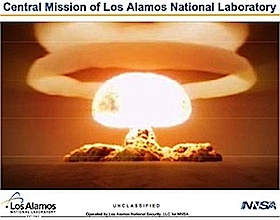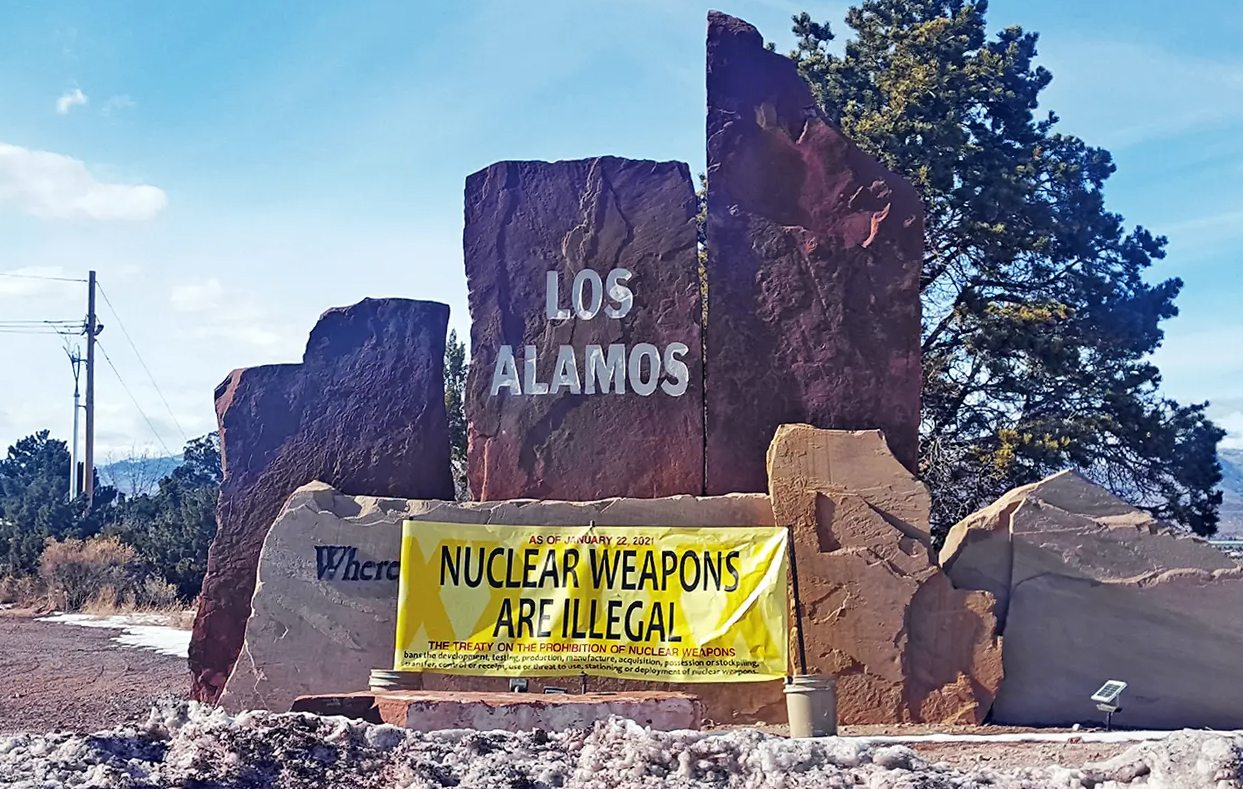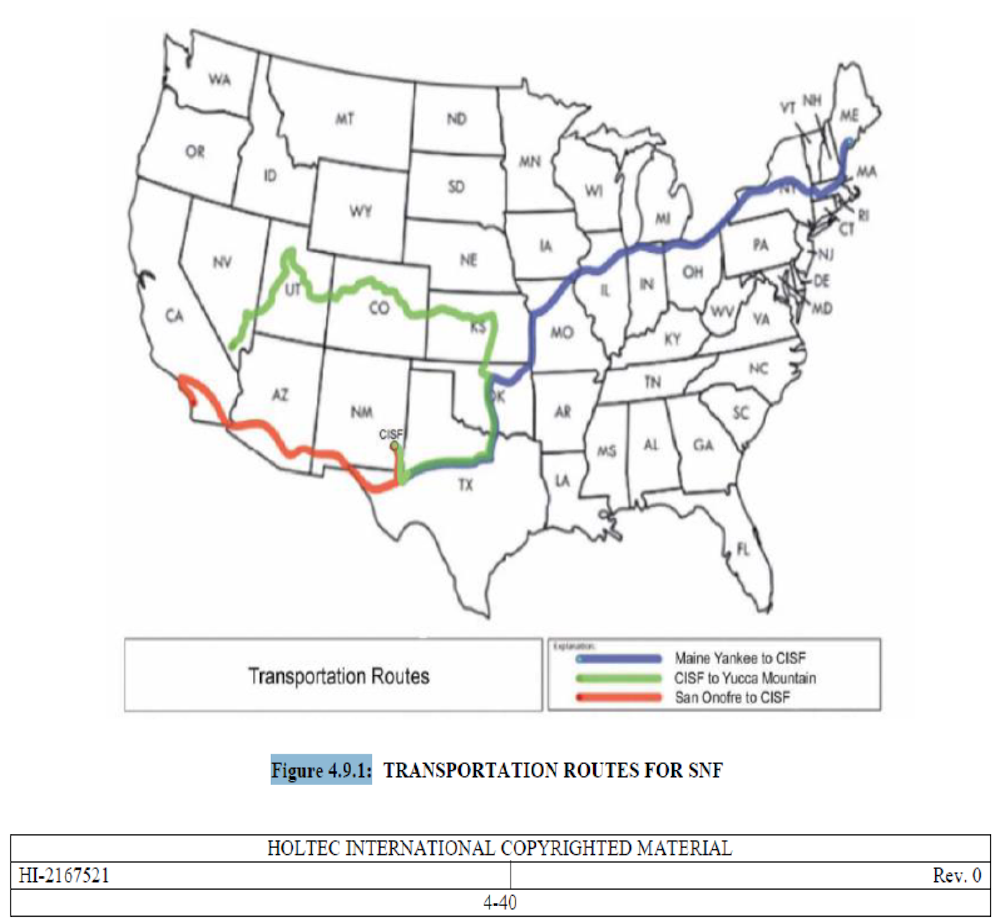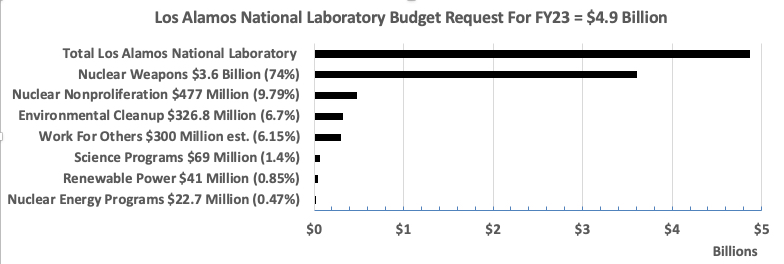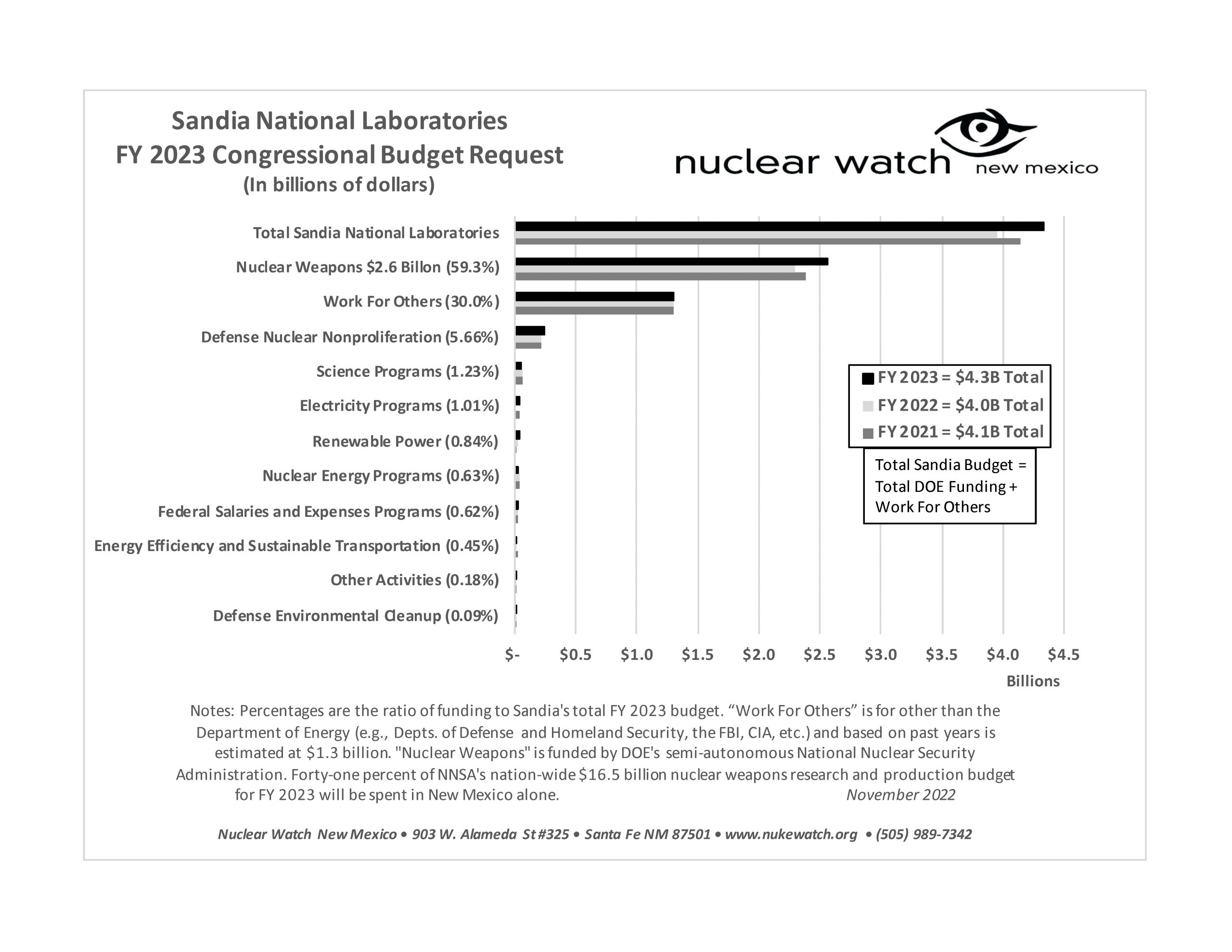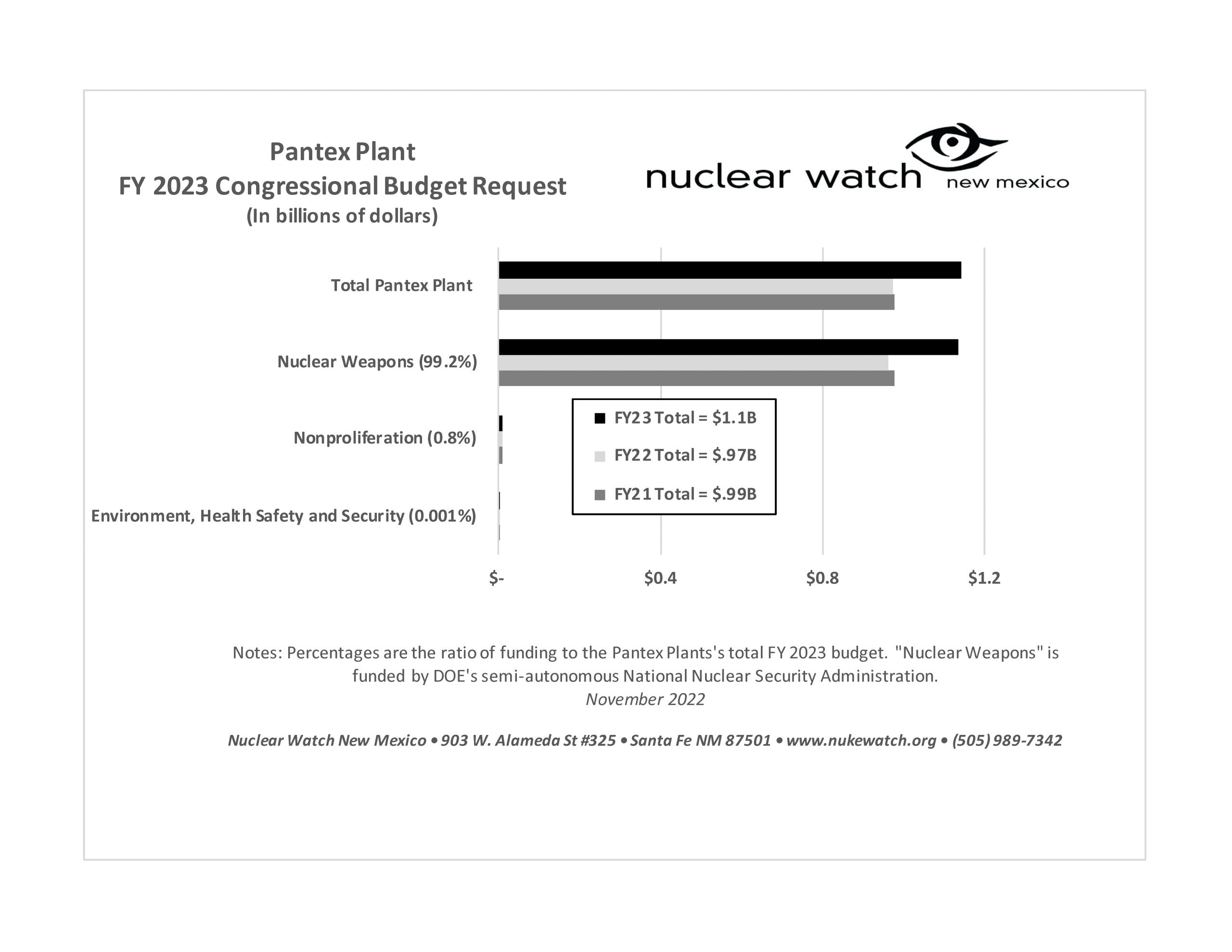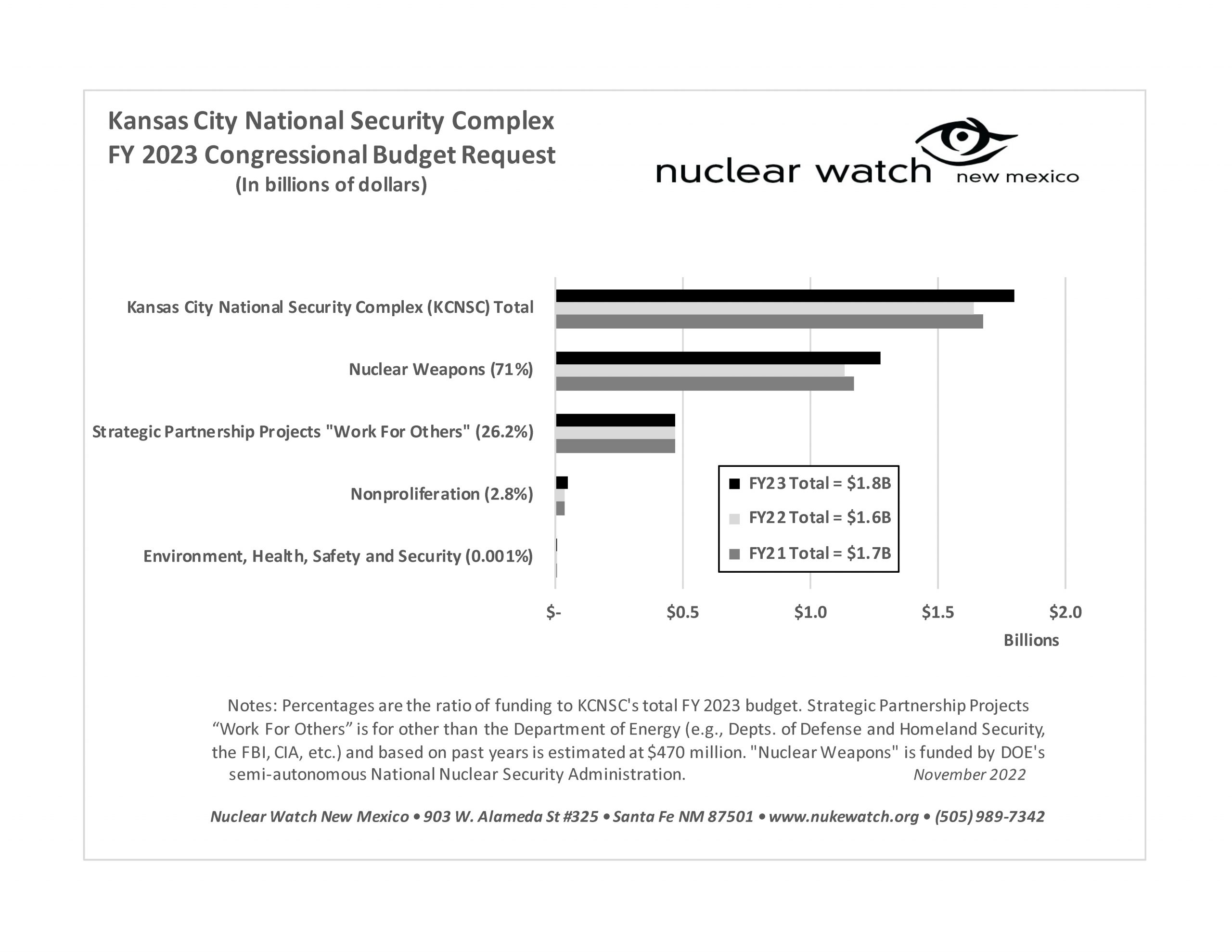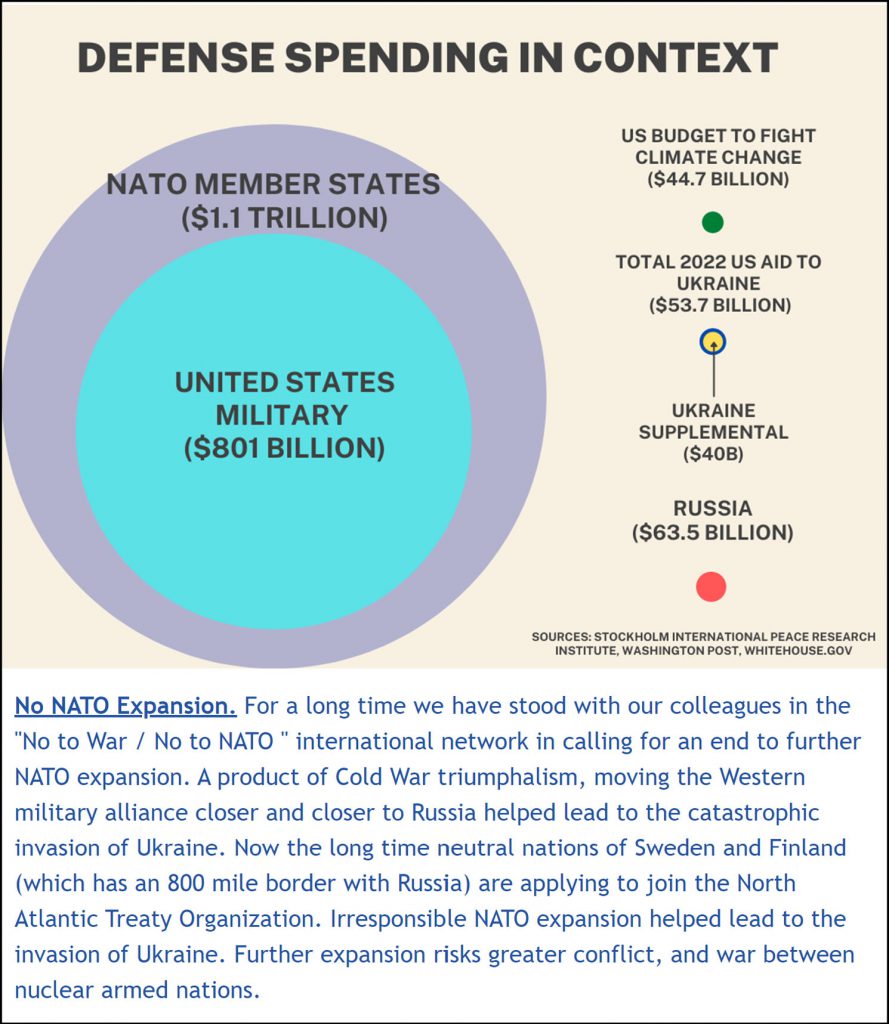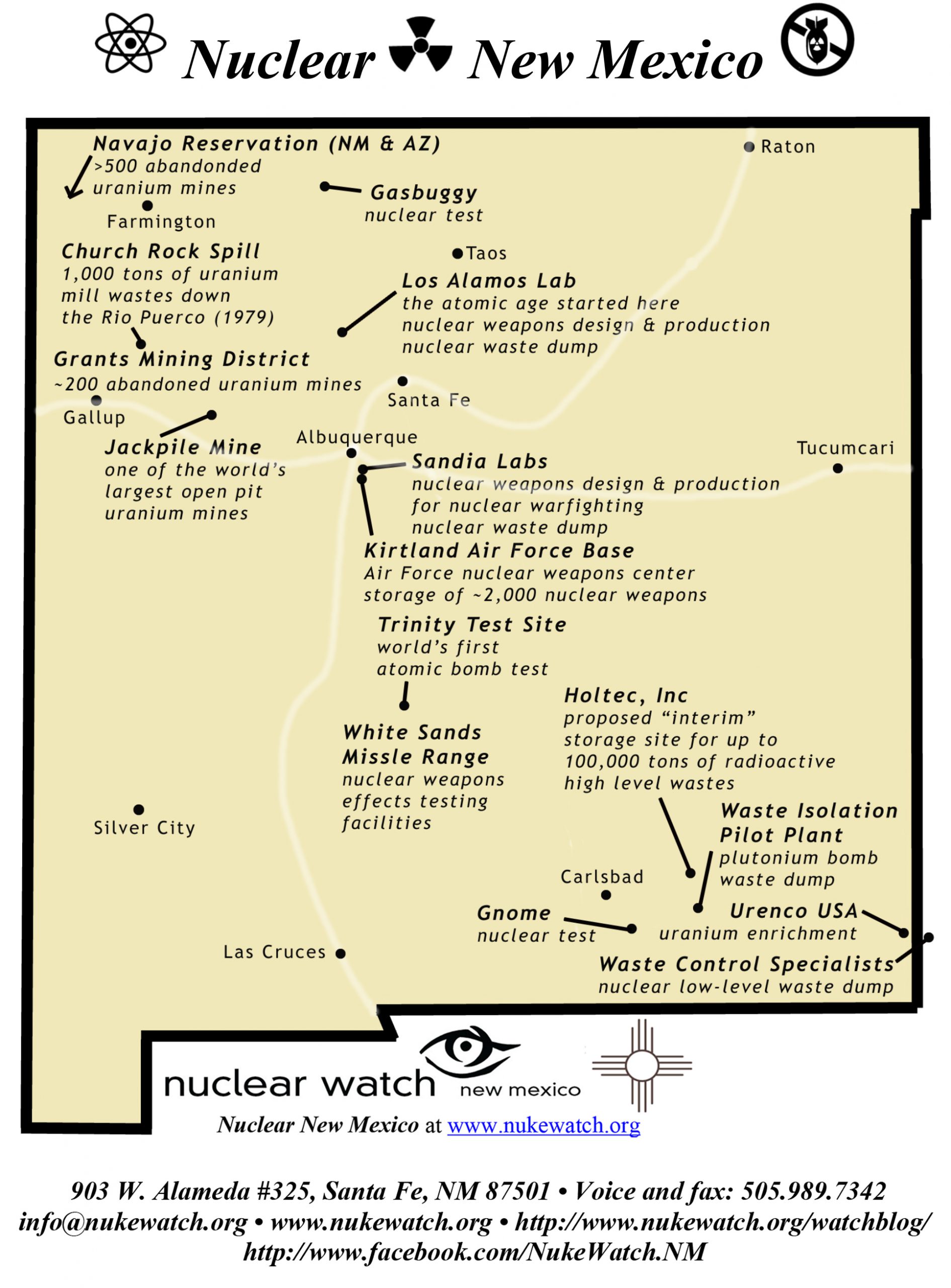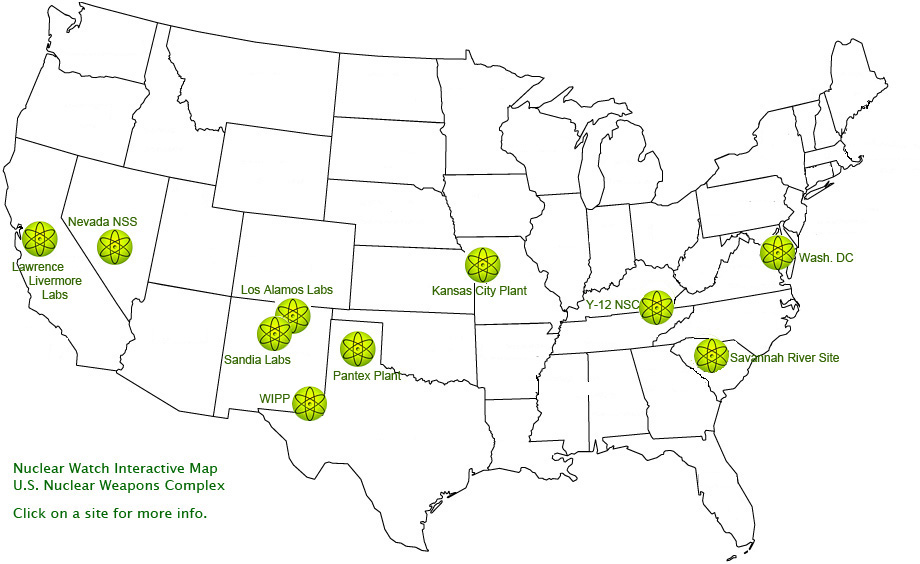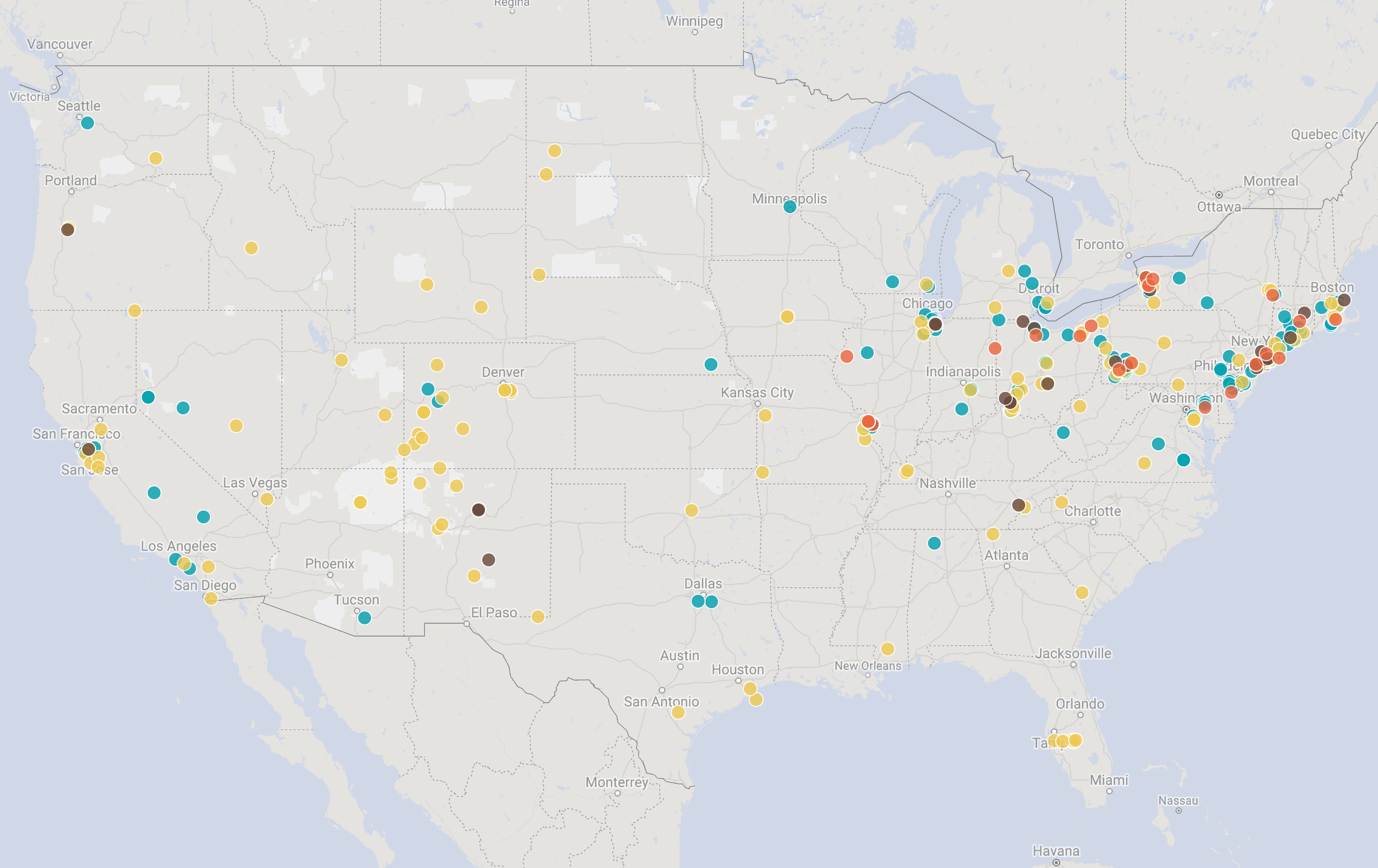QUOTE OF THE WEEK
Nothing Found
It seems we can’t find what you’re looking for. Perhaps searching can help.
LANL’s Central Mission: Los Alamos Lab officials have recently claimed that LANL has moved away from primarily nuclear weapons to “national security”, but what truly remains as the Labs central mission? Here’s the answer from one of its own documents:
LANL’s “Central Mission”- Presented at: RPI Nuclear Data 2011 Symposium for Criticality Safety and Reactor Applications (PDF) 4/27/11
Banner displaying “Nuclear Weapons Are Now Illegal” at the entrance in front of the Los Alamos National Lab to celebrate the Entry Into Force of the Nuclear Weapon Ban Treaty on January 22, 2021
Nothing Found
It seems we can’t find what you’re looking for. Perhaps searching can help.
Follow the Money!
Map of “Nuclear New Mexico”
Nuclear Watch Interactive Map – U.S. Nuclear Weapons Complex
In 1985, US President Ronald Reagan and and Russian President Mikhail Gorbachev declared that “a nuclear war cannot be won and must never be fought.”
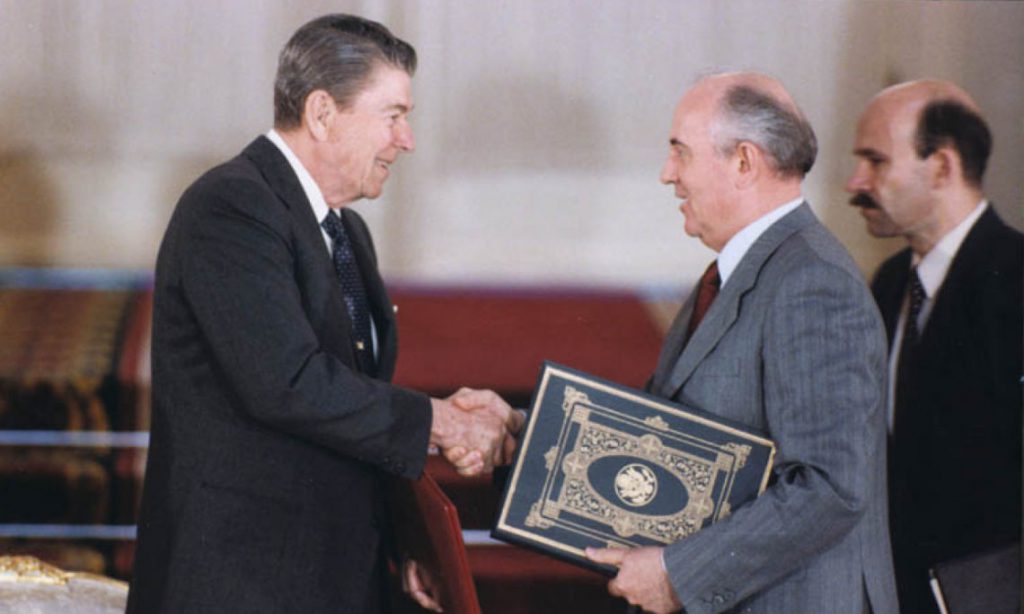
Waste Lands: America’s Forgotten Nuclear Legacy
The Wall St. Journal has compiled a searchable database of contaminated sites across the US. (view)
Related WSJ report: https://www.wsj.com
2022 BLOG POSTS
Nothing Found
It seems we can’t find what you’re looking for. Perhaps searching can help.
New & Updated
Consolidated Nuclear Security LLC Performance Evaluation Report – Wrong B61-12 tail case?
Buried in the just released NNSA FY 2015 Performance Evaluation Report (PER) for Consolidated Nuclear Security LLC (the combined contract for Pantex and Y-12 run by Lockheed Martin and Bechtel) is the remarkable note that Pantex sent to the Defense Department a Joint Test Assembly (JTA) of the B61-12 nuclear smart bomb with the wrong tail case. Generally, a JTA is a full scale mock up of the nuclear weapon (just not nuclear armed), in this case for a real life drop test from an Air Force fighter at the Tonapah Test Range in Nevada (which is run by the Sandia Labs).
P. 5: “CNS experienced several issues with the builds of the new B61 JTA Modernization configurations. CNS experienced quality issues on five of the six First Production Units. The most severe of which was the installation of an incorrect tail case on the JTA S/N 602 that was delivered to Department of Defense (DoD). The DoD chose not to proceed with the flight test and returned the unit to Pantex.” [S/N is the serial number of the particular unit.] – End –
How do you put the wrong tail case on the mock bomb, especially given all the hoopla we’ve heard about the B61-12 and the rush to get it into production? Did this involve the now-well known tail fin kit that turns the “dumb” B61 bomb into the precision-guided B61-12?
A few other worthy items from the CNS PER:
• p. 5: Pantex is falling behind in dismantlements, and this is before the announced planned 20% increase in dismantlements. “CNS achieved 101% of dismantlements related to secondaries and 66% of the revised Production Control Document (PCD) baseline schedule. The low performance against the revised PCD baseline schedule resulted in NNSA falling below the trajectory to achieve the 2022 dismantlement goal.”
Secondaries are dismantled at Y-12, with all of the rest of the nuclear weapon dismantled at Pantex. The 2022 dismantlement goal is to dismantle the ~2,500 nuclear weapons scheduled by 2009 for dismantlement. This does not include any weapons retired since then.
• p. 7: “CNS did not meet the majority of the expectations for scheduled surveillance activities, deliverables, and requirements as documented within each applicable weapons system approved Integrated Weapon Evaluation Team (IWET) Plans and associated directive documents.”
Rigorous surveillance is the prerequisite for maintaining stockpile safety and reliability (the claimed rationale for the Stockpile Stewardship Program), but has chronically suffered lower prioritization.
• p. 10: “W76-1 LEP: CNS achieved 101% of the secondary production schedule, met the military shipment schedule, but only achieved 85% of the total FY15 delivery commitment to the Department of Defense.”
This doesn’t bode well for future Life Extension Programs that are growing only more complex and ambitious.
• p. 11: “CNS is behind schedule on pit recertification projects and is working on recovery plans. The CNS delays have not adversely impacted the B61-12 schedule. However, if delays continue the impacts to the B61-12 schedule are certain.”
• p. 14: The future uranium casting process for the Uranium Processing Facility is still unproven.
“CNS did not fully meet expectations on the use of the production microwave caster in [Building] 9212 [at Y12]. This is partially due to equipment issues including the stack 11 filter issues and a failure in the microwave’s bottom lift assembly. Unfortunately, CNS was unable to recover the schedule. Running the microwave caster early and often is valuable since this technology represents the future Uranium Processing Facility (UPF) casting capability.”
• p. 24: Pantex and Y-12 are beginning “additive manufacturing” (3-D printing) of nuclear weapons components. What are the future proliferation consequences of this?
“CNS began advancing manufacturing capabilities through additive manufacturing initiatives. CNS procured and received a Connex 500-UV Resin multi-color, large-scale plastic machine. This machine will be used for prototyping, proof of principle, displays and cutaways, and training aids. CNS also procured its first metal additive machine and installation will begin at Y-12 in July. Once R&D material testing is complete, the first area of focus will be tooling applications. A second, identical machine has been procured for Pantex and will be delivered late summer for similar applications.”
• p. 35: CNS, composed of Lockheed Martin and Bechtel, gave the construction contract for the Uranium Processing Facility at Y-12 to Bechtel. There was no competition that I heard about.
Concerning Bechtel’s track record, it took the Chemistry and Metallurgy Research Replacement Project at LANL from an original $600 million to $6 billion, and the Waste Treatment Facility at Hanford from $3.5 billion to $13 billion, and it may still never work.
• p. 42: “While NNSA has noted the CAS [Contractor Assurance System] reports have gotten more self-critical over FY15, the CNS end of year self-assessment was not self-critical. Given all the issues this year that impacted mission, it was unusual that the report was not more introspective.”
In fact, CNS gave itself a glowing self-assessment, which NNSA did not agree with. In all, NNSA awarded CNS $11.3 million out of a possible $20 million in incentive fees, along with a fixed fee of $31 million. For NNSA, that’s a pretty big slap on the wrist.
The Performance Evaluations Reports are available at https://nnsa.energy.gov/aboutus/ouroperations/apm/perfevals
NukeWatch successfully sued in 2012 to get the reports publicly released, but NNSA was misbehaving again and did not release the FY 2015 PERs until now. These reports are invaluable for insight into what NNSA sites actually do and related contractor performance. The reports are also becoming increasingly critical of contractor performance ever since the major security incident at Y-12 and the closure of the Waste Isolation Pilot Plant caused by an errant radioactive waste drum from Los Alamos.
NukeWatch Files Second FOIA Request for Los Alamos and Sandia Labs Evaluations, Demand Expedited Release to E-FOIA Reading Room
Santa Fe, NM.
Nuclear Watch New Mexico has filed a second request under the Freedom of Information Act (FOIA) for the National Nuclear Security Administration’s FY 2015 Performance Evaluation Reports for the Los Alamos and Sandia National Laboratories. Nuclear Watch filed its first request on December 22, 2015, which has still not been fulfilled despite the law’s statutory requirement that FOIA requests be honored within 20 working days. Because of that, Nuclear Watch is demanding expedited processing and posting of these reports to an electronic FOIA reading room, as required by the 1996 E-FOIA amendments.
Nuclear Watch NM Files Lawsuit Over Lack of Cleanup at the Los Alamos Lab
Santa Fe, NM.
Nuclear Watch New Mexico has filed a lawsuit in federal court against the Department of Energy and Los Alamos National Security LLC (LANS), the for-profit operator of the Los Alamos National Laboratory, over their failure to meet cleanup milestones under a 2005 “Consent Order” they agreed to with the New Mexico Environment Department. The New Mexico Environmental Law Center is representing NukeWatch in this legal action to enforce cleanup at LANL.
Comment Period Extended for Proposed Los Alamos Cleanup Order
The New Mexico Environment Department’s Hazardous Waste Bureau is extending the public comment period on the proposed changes to the Draft Consent Order which governs legacy clean-up at Los Alamos National Laboratory.
The public comment period now continues through May 31. To obtain a copy of the documents or a portion thereof, visit the NMED website at https://web.archive.org/web/20170109131949/https://www.env.nm.gov/HWB/lanlperm.html under Consent Order.
Written comments must be based on information available for review and include, to the extent practicable, all referenced factual materials.
NMED is scheduled to present on the public comments received to date at the May 18 Northern New Mexico Citizens’ Advisory Committee meeting at the Cities of Gold Hotel, 10-A Cities of Gold Road, Santa Fe, New Mexico from 1:00 P.M. to 5:00 P.M.
AND WE HAVE EXPANDED OUR COMMENTS
Please let your voice be heard and turn in public comments. Copy the sample comments below and paste into an email. Please modify as you see fit, then email to the address below. If you don’t mind, please cc: us at: info(at)nukewatch(dot)org
[date]
Ms. Kathryn Roberts
New Mexico Environment Department
Post Office Box 5469
Santa Fe, New Mexico 87502
Via email to kathryn.roberts@state.nm.us
Dear Ms. Roberts,
I urge the New Mexico Environment Department (NMED) to abandon the proposed 2016 Compliance Order on Consent, or Consent Order, for Los Alamos National Laboratory (LANL), released for public comment on March 30, 2016. It creates serious problems and represents a giant step backwards in achieving the goal of genuine cleanup of the Laboratory.
The Environment Department should keep the existing Consent Order that went into effect March 1, 2005, while modifying and updating a cleanup schedule that includes a realistic final compliance date. I also formally request that NMED provide the opportunity for a public hearing on the revised cleanup schedule and new completion date, in accordance with the New Mexico Hazardous Waste Act and the 2005 Consent Order.
GENERAL COMMENTS
The opportunity for a public hearing must be provided
- Any extension of a final compliance date must be treated as a Class 3 permit modification to the 2005 Consent Order and therefore requires a 60-day public comment period.
- Any extension of a final compliance date under the 2005 Consent Order can be implemented only after the opportunity for public comment and a public hearing, including formal testimony and cross-examination of witnesses.
- The Environment Department is legally required to follow these public participation requirements that explicitly incorporated into the 2005 Consent Order.
Withdraw the proposed draft 2016 Consent Order
- The proposed draft represents a big step backwards in achieving the goal of genuine cleanup of the Laboratory.
- The Environment Department should keep the current 2005 Consent Order and revise the Section XII cleanup schedule and final compliance date.
- I request that the Environment Department withdraw the proposed draft 2016 Consent Order.
The public deserves the opportunity to comment on all following drafts
- It seems likely that a later draft – after the Lab’s and public comments are incorporated into a revised draft – and after closed-door negotiations between the Environment Department and the Laboratory – could be substantially different from the current draft.
- I request that the public have the opportunity to review and comment on any further drafts of a revised proposed 2016 Consent Order.
Public participation provisions in the existing 2005 Consent Order must be incorporated into the proposed draft 2016 Consent Order
- The proposed draft 2016 Consent Order explicitly limits public participation requirements incorporated into the existing 2005 Consent Order.
- I request that all notices, milestones, targets, annual negotiations, and modifications require public review and comment, and the opportunity for a public hearing.
The current state of cleanup must be updated and next steps scheduled
- Work under the existing 2005 Consent Order needs to be subject to public review. In 2005 DOE agreed to complete cleanup under the Consent Order by December 6, 2015, which did not happen. In order for the public to understand where the work under the existing Consent Order stands, LANL should be required to provide a current, publicly available list of the status of all cleanup projects under the 2005 Consent Order.
- Further, I request that next steps for cleanup at every site listed in the 2005 Consent Order be documented in detail and given a scheduled completion date, or alternatively verified as already completed.
- All documents submitted under the 2005 Consent Order must be incorporated into any revised Consent Order.
All documents must be made public as required in the 2005 Consent Order
- The State and the Lab must make all communications, documents, submittals, approvals, notices of deficiencies and denials under any revised Consent Order readily and electronically available to the public.
- The State and the Lab must notify individuals by e-mail of all submittals, as required in the 2005 Consent Order.
The Environment Department must respond in writing to all public comments
- I request that the State reply individually to each and every comment submitted.
- The Lab’s comments and NMED’s response to comments must be made public.
All future work must have enforceable deadlines
- The proposed draft 2016 Consent Order proposes a “Campaign” approach with enforceable cleanup deadlines limited to the work scheduled only for that year.
- I request that all anticipated cleanup projects have scheduled, enforceable cleanup deadlines from the beginning of any revised Consent Order.
The Consent Order cannot be open-ended
- Any Consent Order for LANL cleanup must have a final compliance date to which the State and the Lab agree to and are so bound.
- The public should be given an opportunity for a public hearing on the new final compliance date as required by New Mexico’s hazardous waste regulations.
SPECIFIC COMMENTS
The Proposed 2016 Consent Order Must Not Extend the Original Final Compliance Date Without Required Public Participation
The proposed 2016 consent order would indefinitely extend the final compliance date for completing corrective action at the Laboratory, without the opportunity for a public hearing with formal testimony and cross-examination of witnesses. Any extension of a final compliance date under the 2005 Consent Order requires a 60-day public comment period and the opportunity for a public hearing, including formal testimony and cross-examination. The Environment Department is legally required to follow these procedural requirements.
The legal requirements that mandate a public hearing are clear. Section XII of the 2005 Consent Order establishes the compliance schedule for implementation and completion of corrective actions at specific sites at the Laboratory. This schedule is mandatory. The final report that was to be submitted under the 2005 Consent Order – therefore, the final compliance date – was the remedy completion report for the huge Area G waste dump, required to be submitted by December 6, 2015. The proposed 2016 Consent Order would indefinitely extend this final compliance date by not designating a specific final compliance date.
But this revision must be treated as a major Class 3 permit modification. Section III.W.5 of the 2005 Consent Order explicitly provides for the preservation of full procedural rights for the public as follows:
This Consent Order hereby incorporates all rights, procedures and other protections afforded the Respondents [DOE and UC, now LANS] and the public pursuant to the regulations at 20.4.1.900 NMAC (incorporating 40 C.F.R. § 270.42) and 20.4.1.901 NMAC, including, but not limited to, opportunities for public participation, including public notice and comment, administrative hearings, and judicial appeals concerning, for example, remedy selection decisions of the [Environment] Department.
Thus, extension of a final compliance date under the 2005 Consent Order requires a 60-day public comment period and the opportunity for a public hearing, including formal testimony and cross-examination.
The Proposed New Consent Order Must Not Limit Other Public Participation Procedures
The proposed 2016 Consent Order expressly limits public participation requirements in a way that completely diverges from those provided in the 2005 Consent Order. As explained above, the 2005 Consent Order explicitly protects procedural due process rights available to the public. The proposed 2016 Consent Order explicitly removes these protections, as follows:
The Parties agree that the rights, procedures and other protections set forth at 20.4.1.900 NMAC (incorporating 40 C.F.R. § 270.42), 20.4.1.901 NMAC, and 20.4.1.902 NMAC, including, but not limited to, opportunities for public participation, including public notice and comment, administrative hearings, and judicial appeals, do not apply to modification of the Consent Order itself. [Emphasis added]
Thus, as proposed in the above language, the Parties (the Environment Department, Department of Energy and Los Alamos National Security, LLC) have inappropriately agreed to remove the due process rights, procedures and other protections provided to the public under the Resource Conservation and Recovery Act (RCRA) and the New Mexico Hazardous Waste Act. This provision must be stripped from the proposed 2016 Consent Order.
The Proposed New Consent Order Must Not Eliminate Enforceable Deadlines
The proposed 2016 consent order would eliminate all the deadlines for completing cleanup under the 2005 Consent Order, and replace them with an open-ended and vague scheduling process, with limited enforcement opportunities.
The 2005 Consent Order, in Section XII, established dozens of deadlines for the completion of corrective action tasks, including completion of investigations at individual sites, installation of groundwater monitoring wells, submittal of groundwater monitoring reports, evaluation of remedial alternatives for individual sites, and completion of final remedies. These deadlines are enforceable under section III.G.
The proposed 2016 Consent Order would abandon the 2005 Consent Order provisions and replace them with a so-called “Campaign Approach” under Section VIII. Under Section VIII.A.3, it would be up to the DOE, not the regulator at the New Mexico Environment Department, to select the timing and scope of each “campaign.”
Enforceable deadlines for cleanup tasks would apply no more than one year into the future. Deadlines would be based on “Campaigns” negotiated each year with DOE with no public participation and opportunity to comment on the schedule. To add insult to injury, the annual schedule would be determined by funding at DOE’s discretion, rather than the schedule driving the funding, which was the fundamental approach of the 2005 Consent Order.
All cleanup projects must mandatory completion dates scheduled from the beginning date of any revised Consent Order, and must be fully enforceable.
Existing Violations Must Not Be Eliminated
Section II.A of the proposed 2016 Consent Order would “settle any outstanding violations of the 2005 Consent Order.” This is a get out of jail free card. Without enforceable schedules from the beginning, any consent order is not truly unenforceable, and the Environment Department would be abdicating its responsibility to protect human health and the environment as required by the federal Resource Conservation and Recovery Act (RCRA) and the New Mexico Hazardous Waste Act. NMED must not surrender its regulatory and enforcement powers!
Attorney General Approval Must Be Obtained
The 2005 Consent Order was signed by the Attorney General of New Mexico for purposes of the Covenant Not to Sue (section III.) and the Reservation of Rights (section III.). As indicated on the draft signature page, there is no indication of the NM Attorney General plans to sign the proposed 2016 Consent Order. Yet it would provide the State of New Mexico with a covenant not to sue DOE on behalf of the State of New Mexico, not merely on behalf of the Environment Department. The Attorney General was an active participant, representing the People of New Mexico, in the 2005 Consent Order. The Environment Department has a responsibility to ensure that the NM Attorney General is consulted, and his approval obtained, before any consent order is adopted.
The Proposed 2016 Consent Order Must Not Omit Detailed Requirements Found in the 2005 Consent Order
The 2005 Consent Order includes numerous detailed requirements for such things as well installation, sample collection, and preparation of work plans and reports. These ensure that the cleanup work is done properly, consistently, and according to standard industry practices. They also ensured that work plans and reports were consistent, easy for the Environment Department to review, and easy for the public to understand. The proposed 2016 Consent Order omits many such requirements, which should be corrected.
The Proposed 2016 Consent Order Must Not Allow Budget To Dictate Cleanup
The proposed 2016 Consent Order allows DOE to provide cleanup priorities based on anticipated budget, which is backwards. . By the time NMED receives an estimated annual cleanup budget from DOE, the horse has left the barn. The original purpose of the 2005 Consent Order was to compel DOE and LANL to ask Congress for additional funds to accelerate cleanup. The giant loophole in the proposed 2016 Consent Order that allows DOE and LANL to say that they don’t have sufficient funding and therefore can choose to exempt themselves from cleanup should be eliminated.
Cleanup Levels Must Remain Strict
Section IX Cleanup Objectives and Cleanup Levels of the proposed 2016 Consent Order would allow DOE to “develop site specific ecological cleanup levels” to mitigate unacceptable ecological risk due to release of site-related contaminants. There is no mention of NMED’s role in this process. DOE would be allowed to demonstrate to NMED that any particular “cleanup objective is impracticable.” To do this, DOE may consider such things as technical difficulty, the cost of the project, hazards to workers or to the public, and any other basis that may support a finding of impracticability. If NMED approves the impracticability request, DOE can then propose alternative cleanup methods using site-specific risk assessments. All of this could take place behind closed doors, as there are no public participation requirements in this section. Please clarify what cleanup levels will be used and when and where they will be applied.
New Mexico deserves better
In closing, the Environment Department’s proposed 2016 Consent Order allows the federal government to leave Northern New Mexico contaminated if DOE believes that cleanup is too difficult or costly– a sorry situation indeed for a nuclear weapons facility that receives over 2 billion taxpayer dollars a year. Instead, the New Mexico Environment Department should implement a new revised Consent Order that is aggressive and enforceable and in which the State of New Mexico stays in the driver’s seat, not LANL and DOE. That would be a real win-win for New Mexicans, helping to permanently protect the environment and our precious water resources while creating hundreds of high-paying cleanup jobs. .
Sincerely,
Name
City
The new draft Consent Order is available at
https://www.env.nm.gov/HWB/lanlperm.html#COOC
NMED’s public notice for the draft Consent Order is available at
https://www.env.nm.gov/HWB/documents/PublicNotice__English.pdf
The public comment period ends 5:00 pm May 31, 2016.
Comments should be submitted to kathryn.roberts@state.nm.us
Sample General Comments on the proposed new Los Alamos Cleanup Agreement
The New Mexico Environment Department (NMED) has issued a draft revised Consent Order (CO), which was the agreement in 2005 between the State and the federal Department of Energy (DOE) for fence-to-fence cleanup of legacy Cold War wastes at the Los Alamos National Laboratory (LANL). The Consent Order was designed as a plan-to-make-a-plan with investigations of contaminated sites followed by cleanup decisions and remediation. Milestones and penalties were included to keep funding and cleanup on track.
Serious investigation and cleanup began under the 2005 Consent Order. From 2005 through 2010, DOE and its contractors, under NMED oversight, accomplished significant progressed towards cleanup of the Laboratory. Much investigation work was completed. A large plume of hexavalent chromium was discovered in groundwater. Remedies were completed at dozens of individual sites.
Little cleanup has been accomplished in the last few years. We fear that the new Consent Order, if adopted, would continue that downward trend. It does not have enforceable milestones for all cleanup projects from the beginning. Instead the new plan is for NMED and DOE to decide every 1 to 3 years which sites will be addressed for cleanup “Campaigns”. This may allow Los Alamos to never address all the sites, and revert cleanup back to the way it was done before the 2005 Consent Order with budget driving cleanup. This is contrary to the original purpose of the CO, which was to compel DOE and LANL to get additional money from Congress for cleanup.
NMED’s public notice for the draft Consent Order is available at
https://www.env.nm.gov/HWB/documents/PublicNotice__English.pdf
The new draft Consent Order is available at
https://www.env.nm.gov/HWB/lanlperm.html#COOC
Please let your voice be heard and turn in public comments. Copy the sample comments below and paste into an email. Please modify as you see fit, then email to the address below. If you don’t mind, please cc: us at: info(at)nukewatch(dot)org
The 45-day public comment period ends 5:00 pm May 16, 2016.
Comments should be submitted to:
kathryn.roberts@state.nm.us
Ms. Katherine Roberts
Division Director
New Mexico Environment Department
Post Office Box 5469
Santa Fe, New Mexico 87502
Comments on the proposed new Consent Order
Withdraw this draft
- This draft represents a big step backwards in achieving the goal of genuine, comprehensive cleanup of the Laboratory.
- The Environment Department should keep the current 2005 Consent Order with necessary revisions to the cleanup schedule.
- I request that the Environment Department withdraw this draft Consent Order.
A 45-day comment period on this first draft is inadequate
- The March 30, 2016 draft document is a new Consent Order and, as such, thoroughly reviewing the document is a big task.
- I request that at least another 15 days be added to the public comment period.
The public deserves the opportunity to comment on all following drafts
- It seems likely that a later draft – after the Lab’s and the public’s comments are incorporated – could be substantially different from the current draft.
- I request that the public have the opportunity to comment on any further drafts of the new Consent Order.
Public participation must be put back into the new Consent Order
- The new Consent Order would expressly limit public participation requirements which would be opposite from the 2005 Consent Order.
- I request that all milestones, targets, annual negotiations, and modifications require the opportunity for public review and comment.
The current status of all areas of cleanup must be updated
- A current list of the status of all cleanup at Los Alamos must be included in the new Consent Order.
- I request that the next step for cleanup at every site be documented in detail.
- All previous 2005 Consent Order documents must be incorporated in to the new Consent Order.
All documents must be made public
- The State and the Lab must make all communications, documents, and submittals specified in this Consent Order readily available to the public.
- The State and the Lab shall notify individuals by e-mail of all submittals as specified in this Consent Order.
All future work must have enforceable deadlines
- The new Consent Order would institute a “Campaign” approach with enforceable cleanup deadlines for only one year at a time.
- I request that all cleanup work items have scheduled, enforceable dates.
- The new revised Consent Order creates a giant loophole for DOE and LANL to plead that they don’t have enough funding and therefore don’t have to do the cleanup. The original intent of the Consent Order was to make DOE and LANL get more funding for cleanup from Congress. The “I’m too poor” excuse should be eliminated from any final Consent Order.
The revised Consent Order cannot be open-ended
- Any new Consent Order must have a detailed, enforceable schedule of genuine cleanup milestones.
- I request that the public be given an opportunity for a hearing on the new Consent Order.
Sincerely,
Your name
City
State
NukeWatch NM Heads to DC To Stop U.S. Nuclear Weapons “Trillion Dollar Trainwreck”
NukeWatch NM Heads to Washington to Press Congress, Obama Officials
To Stop U.S. Nuclear Weapons “Trillion Dollar Trainwreck” —
LANL Whistleblower Chuck Montaño to Be Honored
Three members of Nuclear Watch New Mexico will visit Washington, DC from April 17 to April 20 to oppose U.S. Department of Energy (DOE) nuclear weapons projects, which they say will lead to a “trillion dollar trainwreck” through out-of control spending, more radioactive waste generation, and weapons proliferation. The group will meet with the New Mexican congressional delegation, committee staffers, and administration officials with responsibility for U. S. nuclear policies to press for new funding priorities.
The Nuclear Watch NM delegation will be working with more than 50 colleagues from two dozen other states who are participating in the 28th annual Alliance for Nuclear Accountability “DC Days.” They will distribute copies of the ANA’s new report “Trillion Dollar Trainwreck” a detailed analysis of the Obama Administration’s latest plans to spend more money on nuclear weapons without truly enhancing U.S. security.
Jay Coghlan, NukeWatch director and president of the ANA Board of Directors, said, “Massive spending on nuclear weapons ‘modernization’ creates potential catastrophic risks for U.S. taxpayers, the environment and world peace. We will press policy-makers to cut programs that fund dangerous DOE boondoggles. The money saved should be redirected to dismantling weapons and cleaning up the legacy of nuclear weapons research, testing and production.”
NukeWatch NM Steering Committee member Chuck Montaño will receive recognition during DC Days from the Alliance for Nuclear Accountability (ANA) at a reception on April 19, 2015, at the Hart Senate Office Building. He, along with California’s senior U.S. Senator Diane Feinstein and ranking member of the House Armed Services Committee Rep. Adam Smith (D.-WA), will be among those honored by ANA for their efforts to hold the nuclear weapons military-industrial complex accountable. Montaño is being recognized for his advocacy confronting whistleblower and employee abuse, managerial malfeasance and fraudulent activity, all of which he documents in his recently released book detailing the chain of events that led to him becoming a federally protected whistleblower.
Montaño commented that he wrote Los Alamos: Secret Colony, Hidden Truths, “so people can appreciate the Lab’s full impact and legacy, not just what institutional leaders want the public to remember. There are important events I document for posterity, which may otherwise be hidden or erased from memory, and I didn’t want that to happen.”
Jay Coghlan, NukeWatch director, said, “I am very proud of Chuck Montaño, especially since he’s a Nuke Watch Steering Committee member as well. We depend on people like him with the inside story to help keep the Lab safe for communities and workers alike. It’s gratifying to see that the Alliance for Nuclear Accountability and its many member organizations appreciate his efforts.”
Mr. Montaño, a lifelong Santa Fe area resident, was employed at the Los Alamos National Laboratory for 32 years, until his forced retirement from the lab in 2010. He is also the former Director of Fraud and Special Audits for the Office of the New Mexico State Auditor.
The Alliance for Nuclear Accountability (ANA) is a network of three-dozen local, regional and national organizations representing the concerns of communities downwind and downstream from U.S. nuclear weapons production and radioactive waste disposal sites.
# # #
Chuck Montaño’s book Los Alamos: Secret Colony, Hidden Truths
is available at www.losalamosdiary.com
NukeWatch NM Heads to Washington to Press Congress, Obama Officials To Stop U.S. Nuclear Weapons “Trillion Dollar Trainwreck”
Santa Fe, NM
LANL Whistleblower Chuck Montaño to Be Honored
Three members of Nuclear Watch New Mexico will visit Washington, DC from April 17 to April 20 to oppose U.S. Department of Energy (DOE) nuclear weapons projects, which they say will lead to a “trillion dollar train-wreck” through out-of control spending, more radioactive waste generation, and weapons proliferation. The group will meet with the New Mexican congressional delegation, committee staffers, and administration officials with responsibility for U. S. nuclear policies to press for new funding priorities.
Jay Coghlan, NukeWatch director and president of the ANA Board of Directors, said,
“Massive spending on nuclear weapons ‘modernization’ creates potential catastrophic risks for U.S. taxpayers, the environment and world peace. We will press policy-makers to cut programs that fund dangerous DOE boondoggles. The money saved should be redirected to dismantling weapons and cleaning up the legacy of nuclear weapons research, testing and production.”
Watchdogs Demand Expedited Release of Lab Evaluations to E-FOIA Reading Room
Watchdogs File Second FOIA Request for Los Alamos and Sandia Labs Evaluations,
Demand Expedited Release to E-FOIA Reading Room
Santa Fe, NM – Nuclear Watch New Mexico has filed a second request under the Freedom of Information Act (FOIA) for the National Nuclear Security Administration’s FY 2015 Performance Evaluation Reports for the Los Alamos and Sandia National Laboratories. Nuclear Watch filed its first request on December 22, 2015, which has still not been fulfilled despite the law’s statutory requirement that FOIA requests be honored within 20 working days. Because of that, Nuclear Watch is demanding expedited processing and posting of these reports to an electronic FOIA reading room, as required by the 1996 E-FOIA amendments.
In 2009 the National Nuclear Security Administration (NNSA) began to withhold Performance Evaluation Reports without explanation. Accordingly, Nuclear Watch filed a FOIA request for the FY 2009 Los Alamos Lab Performance Evaluation Report that NNSA denied. Nuclear Watch appealed that decision to the Department of Energy’s Office of Hearings and Appeals, which upheld the denial on the basis that the reports contained proprietary information, contrary to the openness and transparency of previous years.
Since that time, the NNSA’s nuclear weapons complex has been rocked by constant cost overruns, security scandals, illegal lobbying and the closure of the multi-billion dollar Waste Isolation Pilot Plant after a faulty radioactive waste drum from LANL ruptured and contaminated workers. It is Nuclear Watch’s belief that American taxpayers deserve to know how their money is being spent on substandard performance by nuclear weapons contractors such as Bechtel, the University of California and Lockheed Martin.
In January 2012 Nuclear Watch filed a FOIA request for the FY 2011 Performance Evaluation Reports of all eight NNSA sites, which the agency again denied. However, rather than fruitlessly appealing to the DOE Office of Hearings and Appeals, the organization filed a lawsuit on March 28, 2012, and began to receive the PERs six days later. Since then the NNSA has publicly released its FY 2012, 2013 and 2014 PERs without having to be compelled by FOIA requests or citizen lawsuits.
However, the National Nuclear Security Administration has not released its FY 2015 Performance Evaluation Reports, which we know have been completed at least for the Los Alamos Lab. On December 17, 2015, LANL Director Charlie McMillan reported to his employees that the Los Alamos National Security, LLC management and operations contract would be put out to bid because of substandard performance as documented by the Performance Evaluation Report.
These reports have been of keen media interest. After its FOIA request was not honored the Albuquerque Journal recently editorialized:
Money to run the labs comes from U.S. taxpayers, who deserve to know how it is being spent and if contractors are doing their jobs in a timely and efficient manner. Past shoddy attention to detail by NNSA contractors and lackadaisical oversight by the U.S. Department of Energy are some of the reasons why the evaluations are critical to protecting national security. The potential search for new contractors makes the evaluations especially critical. They should be made public post haste.
Similarly a respected journalist with the Knoxville News Sentinel reported that his FOIA request was left unfulfilled, and noted that, “The performance reports contain valuable information on how the NNSA contractors are carrying out their missions involving billions of taxpayer dollars annually.” In addition, at least two other nonprofit watchdog organizations, the Oak Ridge Environmental and Peace Alliance and SRS Watch, have FOIAed for NNSA’s Performance Evaluation Reports without success.
These multiple requests by different entities are particularly important because according to the Department of Justice the 1996 E-FOIA amendments
create a new category of records that will be required to receive “reading room” treatment — a category consisting of any records processed and disclosed in response to a FOIA request that “the agency determines have become or are likely to become the subject of subsequent requests for substantially the same records… Second, the amendments will require agencies to use electronic information technology to enhance the availability of their reading room records… To meet this new requirement through on-line access, agencies should have Internet or World Wide Web sites prepared to serve this “electronic reading room” function.
Jay Coghlan, Nuclear Watch New Mexico director, commented, “It is unconscionable that the National Nuclear Security Administration withholds information from the American taxpayer on how fat contractors who constantly bust budgets are paid, especially when these same contractors always have their hands out for yet more taxpayer money for nuclear weapons forever. The question is, what do NNSA and its contractors have to hide? To answer that, Nuclear Watch will not only demand that the Performance Evaluation Report be publicly released, but that from this point on the reports be automatically posted to an electronic FOIA reading room as the law requires. The American taxpayer should not have to fight this battle year after year just to keep greedy nuclear weapons contractors accountable.”
# # #
Nuclear Watch New Mexico’s second Freedom of Information Act request for the Los Alamos and Sandia Performance Evaluation Reports is available at
https://nukewatch.org/importantdocs/resources/NWNM-FOIA-FY15-PERs-4-6-16.pdf
The Albuquerque Journal March 24, 2016 editorial “Tardy posting of NNSA evaluations unacceptable” is available at
https://web.archive.org/web/20160407101502/http://www.abqjournal.com/745237/opinion/tardy-posting-of-nnsa-evaluations-unacceptable.html
Knoxville News Sentinel reporter Frank Munger’s blog post is available at
http://knoxblogs.com/atomiccity/2016/03/14/what-to-think/
The Department of Justice quote is from FOIA Update, Vol. XVII, No. 4 1996
https://www.justice.gov/oip/blog/foia-update-congress-enacts-foia-amendments
NNSA’s Performance Evaluation Reports from 2007 to 2014 are available at
Watchdogs Denounce New Consent Order on Los Alamos Lab Cleanup
For immediate release March 30, 2016
Contacts: Jay Coghlan, 505.989.7342, jay[at]nukewatch.org
Scott Kovac, 505.989.7342, scott[at]nukewatch.org
Watchdogs Denounce New Consent Order on Los Alamos Lab Cleanup
Santa Fe, NM – Today, the New Mexico Environment Department (NMED) issued a new draft Consent Order that in theory will govern cleanup at the Los Alamos National Laboratory (LANL). Instead, the new Consent Order is a giveaway to the Department of Energy and the Lab who are intent on creating yet more radioactive waste from expanded nuclear weapons production.
Jay Coghlan, Nuclear Watch New Mexico Director, commented, “The nuclear weaponeers plan to spend a trillion dollars over the next 30 years completely rebuilding U.S. nuclear forces. Meanwhile, cleanup at the Los Alamos Lab, the birthplace of nuclear weapons, continues to be delayed, delayed, delayed. Real cleanup would be a win-win for New Mexicans, permanently protecting our water and environment while creating hundreds of high paying jobs. But yet the Environment Department fails New Mexicans by failing to enforce cleanup at Los Alamos.”
While announcing the new Consent Order NMED Secretary Ryan Flynn claimed that the old Consent Order process did not work. Nuclear Watch agrees that the old Consent Order failed, but that’s because Secretary Flynn granted more than 150 milestone extensions at the Lab’s request, effectively eviscerating it.
LANL is key to the trillion dollar rebuilding of nuclear forces as the premier nuclear weapons design lab and the nation’s sole production site for plutonium pit triggers, the most critical nuclear weapons components. Funding for Department of Energy (DOE) nuclear weapons programs is nearly double historic Cold War averages, with around $1.5 billion spent annually at LANL alone. In contrast, funding for Lab cleanup has been cut to $189 million for FY 2017, with only approximately a third going to actual cleanup (one-third goes to pensions and another third to safeguard improperly treated radioactive waste barrels, one of which ruptured and closed the multi-billion dollar Waste Isolation Pilot Plant).
The original 2005 Consent Order required DOE and LANL to investigate, characterize, and clean up hazardous and mixed radioactive contaminants from 70 years of nuclear weapons research and production. It also stipulated a detailed compliance schedule that the Lab was required to meet. Ironically, the last milestone, due December 6, 2015, required a report from LANL on how it successfully cleaned up Area G, its largest waste dump. However, real cleanup remains decades away, if ever. Instead, the Lab plans to “cap and cover” Area G, thereby creating a permanent nuclear waste dump in unlined pits and shafts, with an estimated 200,000 cubic yards of toxic and radioactive wastes buried above the regional groundwater aquifer, four miles uphill from the Rio Grande.
A few of the serious deficiencies of the new draft Consent Order are:
[Quotes are from the new draft Consent Order followed by page numbers]
• “The Parties agree that DOE’s project’s plans and tools will be used to identify proposed milestones and targets.” P. 27. “DOE shall define the use of screening levels and cleanup levels at a site…” P. 31. This puts the Department of Energy in the driver’s seat, not the New Mexico Environment Department.
• “DOE shall update the milestones and targets in Appendix B on an annual basis, accounting for such factors as… changes in anticipated funding levels.” P. 28. Therefore the new Consent Order will be held hostage to DOE’s budget, which recently cut LANL’s cleanup funding. This is directly opposite to the intent of the original Consent Order, which was to compel DOE and LANL to get increased funding for accelerated cleanup.
• “… [DOE and NMED] shall meet to discuss the appropriation and any necessary revision to the forecast, e.g. DOE did not receive adequate appropriations from Congress…” P. 29. Again, the new Consent Order and therefore cleanup at LANL will be held hostage to DOE funding, when DOE’s own track record makes clear that its priority is expanded nuclear weapons production paid for in part by cutting cleanup and nonproliferation programs.
• “If attainment of established cleanup objectives is demonstrated to be technically infeasible, DOE may perform risk-based alternative cleanup objectives…” P. 33. DOE can opt out because of “impracticability” or cost of cleanup. P. 34. This creates giant loopholes that threaten comprehensive cleanup at LANL.
• The new draft Consent Order explicitly states that public participation requirements do NOT apply to future modifications of the Order. P. 24. This is the opposite of what the original Consent Order required, which made a point of incorporating the public process requirements of federal environmental law. Nuclear Watch New Mexico maintains that full public participation requirements apply to the new Consent Order as well, including its very formulation as a modification of the old Consent Order. That full public participation process requires a public hearing if there are unresolved issues, which NMED has preemptively rejected, a position that may be of questionable legality.
On January 20, 2016, Nuclear Watch New Mexico formally notified LANL and DOE that it intends to sue them for failing to meet compliance milestones in the old Consent Order. We still expect to take that action sometime after the required 60 day notice period, as in our view this new Consent Order does nothing to remedy those violations.
# # #
The new draft Consent Order is available at
https://www.env.nm.gov/HWB/lanlperm.html#COOC
NMED’s public notice for the draft Consent Order is available at
https://www.env.nm.gov/HWB/documents/PublicNotice__English.pdf
The 45-day public comment period ends 5:00 pm May 16, 2016.
Comments should be submitted to kathryn.roberts@state.nm.us
NukeWatch Denounces New Consent Order on Los Alamos Lab Cleanup
Santa Fe, NM.
Today, the New Mexico Environment Department (NMED) issued a new draft Consent Order that in theory will govern cleanup at the Los Alamos National Laboratory (LANL). Instead, the new Consent Order is a giveaway to the Department of Energy and the Lab who are intent on creating yet more radioactive waste from expanded nuclear weapons production.
Nuclear Watch New Mexico Action Alert – Release of Revised Los Alamos Cleanup Agreement
Nuclear Watch New Mexico Action Alert
NM Environment Department Plans to Unveil Revised Los Alamos Cleanup Agreement
March 30, 2016, 1PM, Sandia Resort
Public Comment Is Invited
Los Alamos Cleanup At the Crossroads
NM Environment Department and officials from Los Alamos National Laboratory plan to roll out a draft of the revised Consent Order, which is the agreement for fence-to-fence cleanup of legacy Cold War waste from nuclear weapons production and research. The last compliance date of the original agreement was December 6, 2015, and although much investigation was completed, much more work is still needed.
Nuclear Watch New Mexico believes
- A new schedule is mostly what is needed
- Lack of budget cannot be an excuse for lack of cleanup
- Particular items to keep – meaningful public comment and a final date
But we suspect big changes and not all for the better protection of Northern NM.
Your voice will be important! Please join us!
Northern New Mexico Citizens’ Advisory Board Meeting
March 30, 2016
1:00 p.m. to 5:15 p.m.
Sandia Resort, Ballroom A
30 Rainbow Road
Albuquerque, New Mexico 87113
DRAFT AGENDA
Time Action Presenter
1:00 p.m. Call to Order Lee Bishop, DDFO
Welcome and Introductions Doug Sayre, Chair
Approval of Agenda
Approval of Minutes of January 27, 2016
1:20 p.m. Old Business
a. Written Reports – See Packet Enclosures (5 minutes)
b. Other items
1:30 p.m. New Business
1:35 p.m. Update from Deputy Designated Federal Officer(s)
Lee Bishop/Michael Gardipe
1:45 p.m. Presentation on Revisions to Consent Order,
Upon Opening of Public Comment Period
NMED Secretary Ryan Flynn
3:00 p.m. Break
3:20 p.m. Presentation Continues
4:00 p.m. Public Comment Period
4:15 p.m. Update on FY 17/18 EM Budget Genna Hackett
4:45 p.m. Consideration and Action on Draft Recommendation 2016-02, Doug Sayre
“FY 2018 Budget Priorities”
5:00 p.m. Wrap-up Comments from NNMCAB Members
a. Were your questions answered regarding the presentations?
b. Requests for future presentations or information
c. Proposed Recommendations
5:15 p.m. Adjourn Michael Gardipe
For more information:
This NNMCAB Agenda-
http://energy.gov/sites/prod/files/2016/03/f30/March_30_16_Draft_Agenda_R7.pdf
Los Alamos Cleanup At the Crossroads
New Cleanup Agreement Requires New Schedule and That Is About All
Baseless Claims?
Nuclear Watch NM Gives Notice of Intent to Sue Over Lack of Cleanup at the Los Alamos Lab
Nuclear Watch NM Gives Notice of Intent to Sue Over Lack of Cleanup at the Los Alamos Lab
NukeWatch Calls for Public Seats at the Table in LANL Cleanup Negotiations
NukeWatch Calls for Public Seats at the Table in LANL Cleanup Negotiations
Through comprehensive research, public education and effective citizen action, Nuclear Watch New Mexico seeks to promote safety and environmental protection at regional nuclear facilities; mission diversification away from nuclear weapons programs; greater accountability and cleanup in the nation-wide nuclear weapons complex; and consistent U.S. leadership toward a world free of nuclear weapons.
Nuclear Watch New Mexico
903 W. Alameda, #325
Santa Fe, NM 87501
505.989.7342 – phone and fax

STAND AGAINST THE RUSH TO RE-OPEN AN UNSAFE WIPP
STAND AGAINST THE RUSH TO RE-OPEN AN UNSAFE WIPP
The U.S. Department of Energy (DOE) has announced that it intends to re-open the Waste Isolation Pilot Plant (WIPP) in December 2016. The nation’s only deep geologic repository, located 26 miles east of Carlsbad, has been shut down since February 2014 because of two events – an underground fire and a radiation release.
DOE is in a rush to re-open WIPP even though the facility cannot meet the previous operational and safety standards, let alone more stringent requirements that are necessary to prevent future accidents. The WIPP underground remains contaminated, so operations have to be greatly changed, including workers being dressed in “ebola suits.” Ventilation will not be restored to the pre-2014 levels until 2021 or later – the new system is not designed and how much it will cost is unknown.
The transuranic (plutonium-contaminated) waste from manufacturing nuclear bombs can be in safe storage at the generator sites, so there is no emergency requiring the rush to re-open.
DOE is rushing to re-open WIPP and ALSO wants to expand WIPP to other missions that are prohibited by law, including:
- Greater-Than-Class C waste from dozens of commercial power plants;
- High-level waste from Hanford, WA;
- Commercial waste from West Valley, NY;
- Surplus weapons-grade plutonium from the Savannah River Site, SC.
DOE also is proceeding with finding a “volunteer” site for the nation’s high-level defense waste, and some officials in southeastern New Mexico say publicly that WIPP should be that repository!
The 1992 WIPP Land Withdrawal Act explicitly PROHIBITS all high-level waste, all spent nuclear fuel, and all commercial waste. But DOE wants to ignore the law!
Those prohibitions resulted from many New Mexicans demanding them!
WHAT YOU CAN DO:
Contact Senators Udall and Heinrich (and other elected officials) and ask them to stop the rush to re-open an unsafe WIPP. Ask them to require DOE to drop the expansion proposals and commit that WIPP will not be considered for high-level waste. Ask them to have Congress reiterate that the WIPP law is not being changed to allow those expansions.
FOR MORE INFORMATION:
Southwest Research and Information Center, www.sric.org, 505-262-1862
Citizens for Alternatives to Radioactive Dumping, contactus@cardnm.org, 505-242-5511
Concerned Citizens for Nuclear Safety, www.nuclearactive.org, 505-986-1973
Nuclear Watch New Mexico, www.nukewatch.org, 505-989-7342
Here is a sample letter to use as-is or to modify. You can use the electronic message system at the Senators’ offices.
Senator Udall’s electronic message system: https://www.tomudall.senate.gov/?p=contact
Senator Heinrich’s electronic message system: https://www.heinrich.senate.gov/contact/write-martin
Senator Tom Udall Senator Martin Heinrich
531 Hart Senate Office Building 303 Hart Senate Office Building
Washington, DC 20510 Washington, DC 20510
Dear Senator Udall and Senator Heinrich:
I am very concerned about the Department of Energy (DOE) rushing to re-open WIPP this year despite unresolved public and worker safety issues and because of the many proposals to expand WIPP, if it is re-opened.
The WIPP underground remains contaminated, so operations have to be greatly changed, including workers being dressed in “ebola suits.” Ventilation will not be restored to the pre-2014 levels until 2021 or later – the new system is not designed and how much it will cost is unknown.
The transuranic (plutonium-contaminated) waste from manufacturing nuclear bombs can be in safe storage at generator sites, so there’s no emergency requiring the rush to re-open.
DOE recently announced that it wants to expand WIPP for commercial Greater-than-Class C (GTCC) waste from nuclear reactors and for tons of weapons-grade plutonium. DOE also wants to have a defense high-level waste repository and some people want to “volunteer” WIPP!
There is time for my requests to be fulfilled. Please:
* Tell DOE to improve the ventilation and other safety requirements before WIPP re-opens
* Insist that DOE drop the expansion proposals
* Require DOE to affirm that WIPP will not be considered for the defense high-level waste repository
* Obtain additional congressional assurances that the WIPP law is not going to be changed to allow the proposed expansions.
WIPP is a public health and safety issue now and for many generations to come!
Thank you.
_______________________________________
Name
___________________________________________________________NM________________
Address City State Zip

Los Alamos Cleanup At the Crossroads: Treat All Los Alamos Lab Radioactive Wastes Consistently
Los Alamos Cleanup At the Crossroads:
Treat All Los Alamos Lab Radioactive Wastes Consistently
The Defense Nuclear Facilities Safety Board’s role and responsibility includes gathering information regarding the hazards to the public and workers posed by the management of transuranic (TRU) wastes at Los Alamos National Laboratory (LANL), as well as the Department of Energy’s (DOE) plans to address those hazards. The Board will examine DOE’s actions taken or inadequacies addressed in the current safety policies of the various facilities that manage or store TRU wastes at LANL. The Board is also interested in understanding actions taken to improve TRU waste management at LANL after the improper handling and treatment of TRU wastes that resulted in a ruptured barrel that shut down the Waste Isolation Pilot Plant (WIPP).
Los Alamos Cleanup At the Crossroads – New Cleanup Agreement Requires New Schedule and That Is About All
Los Alamos Cleanup At the Crossroads
New Cleanup Agreement Requires New Schedule and That Is About All
Following protracted negotiations, threatened litigation, and claims of imminent and substantial endangerment, the New Mexican Environment Department (NMED), the Department of Energy (DOE) and the Los Alamos National Laboratory (LANL) contractor agreed to sign the original Consent Order in March 2005. Its promise was fence-to-fence cleanup of Cold War legacy waste at Los Alamos. The 2005 Consent Order was designed as a plan-to-make-a-plan, with investigations followed by cleanup and with hundreds of specific milestones. The intent was to convince DOE to increase funding for LANL cleanup by making a complete cleanup schedule subject to enforcement. The original CO had a “final compliance date” scheduled for December 6, 2015.
However, in 2012, NMED signed a “Framework Agreement” with DOE that prioritized the transfer of 3,706 cubic meters of aboveground, “transuranic” (TRU) nuclear bomb production wastes from LANL to the Waste Isolation Pilot Plant (WIPP) in southern New Mexico. This put Consent Order cleanup on the back burner. Approximately 150 milestone extensions of the 2005 CO were granted to LANL by NMED. In February 2014, WIPP was shut down by improper packaging at LANL of a drum of this waste. Dealing with the remaining “suspect” drums (packaged at the same time) at LANL is a major priority lately instead of cleanup. This has kept the Consent Order cleanup on the back burner.
- Just change the schedule
So NMED and LANL could pick a new final cleanup date, say 2030, and work backwards. Or start by adding 4 or 5 years to the old schedule for some reports and work it out from there. The point is to keep the original 2005 Consent Order language, which is very protective of the health and environment of Northern New Mexico, and just change the schedule dates. However the work is rescheduled, all the work items in the old Compliance Schedule Tables need to be addressed in new Compliance Schedule Tables with new dates given for all the work.
Recent public presentations by NMED implied that cleanup milestones in a revised CO would be assigned annually based on the anticipated budget. This would leave hundreds of cleanup items with no target date for completion and would leave cleanup at the mercy of Congressional budget winds. Any cleanup item not on the list for any given year could be outside the scope of enforcement. LANL could be in the position to not put items on the annual list and to delay cleanup forever.
If the schedule must be rearranged into some sort of “Campaign Mode” in an attempt to make cleanup more “efficient”, completion dates must be kept for every step. Every item in the Campaign must remain enforceable with concrete milestones including a final compliance date. All other items not in a Campaign must remain scheduled.
- Lack of budget cannot be an excuse for lack of cleanup
Taking cleanup dollar crumbs and sprinkling them annually over some perceived priority cleanup items is the least efficient way to address the fence-to-fence cleanup of Cold War wastes at Los Alamos. Cleanup of the 70 years worth of contamination will never again be cheaper than it is this year. It is imperative that ambitious schedule be made and that it be kept.
Every day of delay means another day of Cold War radioactive and hazardous wastes leaking into the environment of Northern New Mexico.
- Particular items to keep – meaningful public comment and a final date
NMED Secretary Ryan Flynn stated publicly (starting at 8:00 min) that the need for a final cleanup date at Los Alamos is critical to Congress for funding. He presented a map that showed that Los Alamos National Laboratory was the only DOE weapons site without final cleanup date. (Slide 4) Instead, cleanup at LANL is listed as “TBD” (To Be Determined).
The final compliance date for the last work item must keep the Class 3 permit modification language. Please see our earlier blog for more information. This will ensure that the public can be heard at the end of the next CO and requires the opportunity for a public hearing.
There must be meaningful public input for the revised CO. NMED must give response to all comments.
A well-planned schedule with concrete milestones and final compliance dates would get the work done faster and cheaper. Course corrections with schedule adjustments will have to be made along the way. This would be expected for such a complex task. Having to adjust the schedule is no reason to throw it out. Any major rewrite of the 2005 Consent Order may only leave the future of NM less protected.
Not keeping up with changes in the 2005 Consent Order schedule is the main reason that the CO needs to be revised today. We currently find ourselves with cleanup of legacy wastes in such disarray that it seems that the only fix is to start over. But there is no reason not to just update the original 2005 schedule. Secretary Flynn has stated that the 2005 Consent Order is still in effect.
Today we could be looking at a known Consent Order with a new schedule. Instead we may end up with NMED and DOE renegotiating some untried document with unknown benefits and an unknown schedule.
Cleanup at Los Alamos National Laboratory is too important to leave as TBD.

ACTION ALERTS
Nothing Found
It seems we can’t find what you’re looking for. Perhaps searching can help.
Nothing Found
It seems we can’t find what you’re looking for. Perhaps searching can help.
Interfaith Panel Discussion on Nuclear Disarmament - August 9
Nothing Found
It seems we can’t find what you’re looking for. Perhaps searching can help.
New Nuclear Media
Nothing Found
It seems we can’t find what you’re looking for. Perhaps searching can help.

